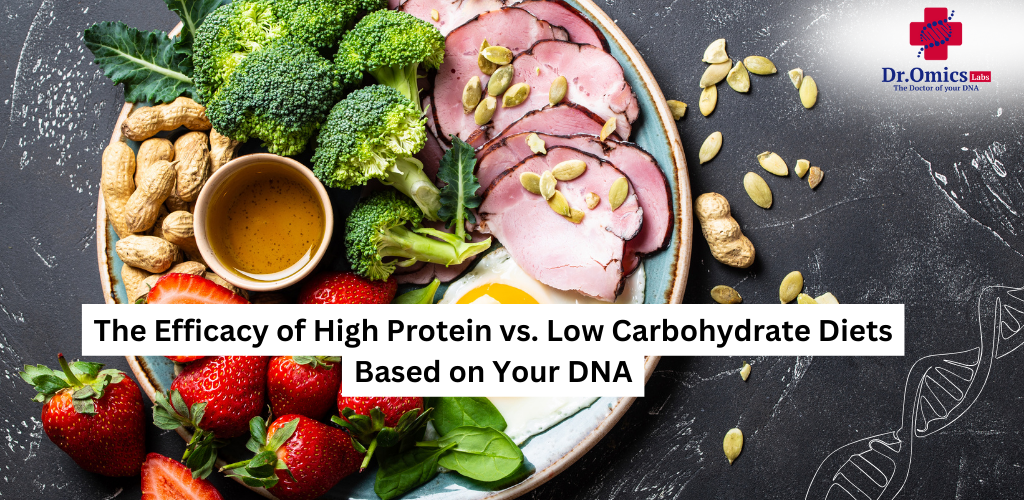The intersection of nutrigenomics and personalized nutrition has revolutionized dietary approaches, offering tailored strategies based on genetic predispositions. The debate between high-protein and low-carbohydrate diets has been long-standing, but recent research suggests that an individual’s genetic profile plays a crucial role in determining the efficacy of these dietary regimens. Understanding the impact of protein diet genetics, low-carb diet DNA, and a genetic diet plan can significantly enhance metabolic efficiency, optimize weight management, and reduce the risk of chronic diseases.
The Role of Genetics in Macronutrient Metabolism
Genetic variations influence how individuals metabolize macronutrients, including proteins and carbohydrates. Several genes regulate metabolic pathways, impacting dietary responses:
- FTO (Fat Mass and Obesity-Associated Gene): Variants in this gene influence obesity risk and macronutrient metabolism.(1)
- PPARG (Peroxisome Proliferator-Activated Receptor Gamma): Regulates lipid metabolism and insulin sensitivity, impacting carbohydrate tolerance.(2)
- APOA2 (Apolipoprotein A2): Affects lipid metabolism and satiety, modulating the effectiveness of high-protein diets.(3)
- TCF7L2 (Transcription Factor 7-Like 2): Linked to glucose metabolism and type 2 diabetes risk, affecting responses to carbohydrate intake.(4)
These genetic markers determine how efficiently an individual processes dietary proteins and carbohydrates, making personalized dietary recommendations more effective than generic guidelines.
High-Protein Diets: Genetic Influence and Benefits
High-protein diets, typically consisting of 30-40% of daily caloric intake from protein, offer several benefits, including enhanced satiety, lean muscle retention, and improved metabolic health. However, genetic predispositions play a crucial role in determining their effectiveness. Variants of the FTO gene contribute to improved weight loss outcomes with higher protein intake by enhancing satiety signals, while individuals with the APOA2 gene variant experience better appetite control on such diets. Additionally, efficient activity of the PEPCK-C enzyme supports energy production from amino acids by enhancing protein metabolism. High-protein diets also aid in muscle protein synthesis, minimizing muscle loss during caloric restriction. They further promote satiety by increasing the secretion of peptide YY (PYY) and glucagon-like peptide-1 (GLP-1), while also helping reduce cravings and stabilize blood sugar levels, particularly in genetically susceptible individuals.
Low-Carbohydrate Diets: DNA-Driven Adaptation
Low-carb diets, typically comprising <20% of daily caloric intake from carbohydrates, are widely recognized for their role in weight management and metabolic health. However, genetic factors dictate the adaptability to such dietary patterns.
- TCF7L2 Gene and Carbohydrate Sensitivity: Individuals with specific TCF7L2 variants exhibit heightened insulin resistance and benefit significantly from carbohydrate restriction.(4)
- PPARG Variants and Fat Metabolism: Those with PPARG polymorphisms may experience greater fat oxidation and improved metabolic flexibility on low-carb diets.(2)
- CPT1A and Fatty Acid Oxidation: Genetic variations in CPT1A (Carnitine Palmitoyltransferase 1A) affect lipid oxidation efficiency, influencing how well an individual thrives on a low-carb diet(5).
Key Benefits:
- Enhances fat oxidation and ketogenesis in individuals with optimized CPT1A activity.
- Stabilizes blood glucose levels and improves insulin sensitivity, particularly in those with high genetic diabetes risk.
- Reduces triglyceride levels and enhances lipid metabolism.
Genetic Diet Plan: Personalized Nutrition for Optimal Results
A genetic diet plan incorporates DNA-based insights to design an individualized approach:
- Genetic Testing: Identify key genetic polymorphisms influencing macronutrient metabolism.
- Nutrient Timing: Align dietary intake with genetic predispositions for optimal energy utilization.
- Macronutrient Distribution: Tailor protein and carbohydrate intake to genetic profiles for enhanced metabolic efficiency.
- Supplementation Strategies: Address genetic deficiencies impacting metabolism, such as omega-3 needs for PPARG variants.
- Continuous Monitoring: Adjust dietary protocols based on metabolic responses and genetic interactions.
Conclusion
Advances in nutrigenomics highlight the necessity of personalized dietary strategies over one-size-fits-all approaches. Whether a high-protein or low-carbohydrate diet is more effective depends largely on genetic predispositions. Individuals can optimize their health outcomes by leveraging insights from protein diet genetics, low-carb diet DNA, and a genetic diet plan, ensuring a diet tailored to their unique metabolic blueprint. Genetic testing, coupled with precise dietary modifications, represents the future of personalized nutrition and optimal metabolic health.
References




